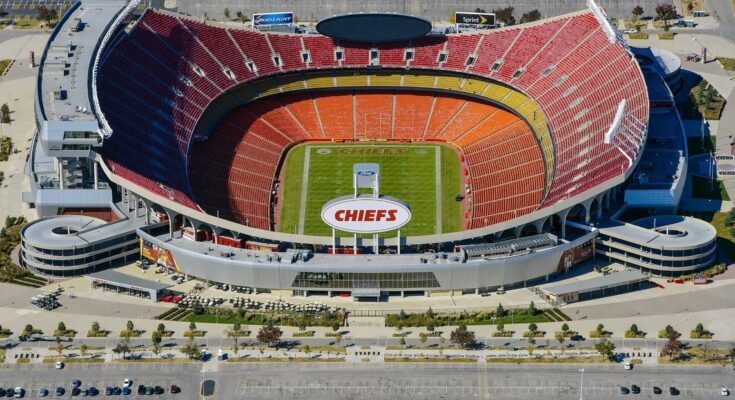Kansas City Chiefs Unveil Plans for \$3 Billion Domed Stadium Designed to Host Future Super Bowls.
The Kansas City Chiefs have taken a bold step into the future of professional football by unveiling plans for a brand-new, state-of-the-art stadium with a projected cost of \$3 billion. This stunning new venue, complete with a fully enclosed dome, is being billed as “Super Bowl-ready,” and marks a significant moment in the franchise’s history as it seeks to redefine the fan experience and secure its place among the NFL’s premier destinations.
After years of speculation and internal discussions about the future of their longtime home at Arrowhead Stadium, the Chiefs organization has decided to move forward with a revolutionary project that could reshape not only the team’s identity but also the sports and entertainment landscape of the entire Midwest. The proposed stadium, designed with the goal of hosting major events such as Super Bowls, Final Fours, and large-scale concerts, represents a dramatic vision for what the next generation of NFL stadiums could look like.
The renderings revealed to the public showcase an architectural marvel. The new stadium boasts a sleek, modern exterior with sweeping lines and glass features that create an open, inviting presence. Inside, fans can expect an immersive experience, with a 360-degree video halo board, luxury suites, club-level amenities, and seating designed for optimal views throughout the building. The dome will allow for year-round use, regardless of weather, ensuring Kansas City can attract not only NFL playoff games but a variety of non-football events that require climate control and high-capacity seating.
This plan is not just about football. It’s about creating a destination. The Chiefs envision a facility that serves as the centerpiece of a broader entertainment complex. The stadium will be accompanied by mixed-use development, including retail spaces, restaurants, hotels, and possibly even residential areas. The goal is to turn the area into a hub of activity, not only on game days but throughout the year, injecting energy and economic growth into the community.
From a strategic standpoint, the decision to build a domed stadium is rooted in more than just aesthetics. For years, Kansas City has been overlooked as a Super Bowl host site primarily because Arrowhead, while beloved, is an open-air stadium subject to brutal winter weather. A dome changes that dynamic instantly. With a controlled climate, modern amenities, and the backing of a passionate fan base, Kansas City becomes a legitimate contender to host the NFL’s biggest game — a massive economic driver and a point of prestige.
Team owner Clark Hunt emphasized the importance of staying competitive with other franchises, many of which have already invested heavily in their facilities. In a league where stadium experiences play a huge role in revenue, branding, and recruiting free agents, Hunt and his leadership team are making a calculated play to ensure the Chiefs remain at the forefront of the NFL’s evolution. He noted that while Arrowhead Stadium has provided decades of unforgettable memories, it’s essential to think long-term and plan for the next 50 years.
The timing of the announcement coincides with a crucial moment in franchise history. With Patrick Mahomes under contract for the foreseeable future and the team continuing to chase championships, there’s a sense of urgency and optimism. The Chiefs want to give their fans — some of the most loyal in all of sports — a home worthy of the team’s accomplishments and aspirations. The new stadium would represent the culmination of Kansas City’s rise to prominence on the national stage.
Renderings of the proposed stadium also highlight the commitment to sustainability and innovation. Green building practices, energy-efficient technology, and environmentally friendly materials are all expected to play a role in construction. In addition, the stadium’s infrastructure will support cutting-edge connectivity, offering fans seamless digital engagement through mobile apps, augmented reality features, and personalized services.
Of course, any project of this scale involves challenges. Financing remains a central question, with discussions ongoing about the mix of public and private funds that will be needed to bring the vision to life. The Chiefs have expressed their intent to work closely with local government officials, community stakeholders, and voters to ensure the project reflects the needs and values of the region. The hope is that the economic benefits of increased tourism, job creation, and long-term development will outweigh any short-term concerns about cost.
There’s also the emotional factor. Arrowhead Stadium is more than a structure — it’s a sacred place to generations of Chiefs fans. The sound of the crowd, the traditions, and the historic moments that unfolded on that field are etched into the city’s identity. The organization is sensitive to this and has pledged to honor the legacy of Arrowhead while embracing the opportunities of a new beginning. Plans include commemorative installations, tributes to legendary players and coaches, and design elements that nod to the past even as the team looks forward.
As part of the roll-out, the Chiefs launched a website featuring a virtual tour of the stadium renderings and an interactive platform where fans can offer feedback and suggestions. The team wants the community to feel involved in the process, reinforcing the idea that this isn’t just about corporate ambition — it’s about building something meaningful together.
In terms of timeline, the Chiefs have not provided an exact construction start date, but sources indicate that the goal is to open the new stadium by the end of the decade. This gives the organization time to finalize design details, secure funding, and coordinate logistical elements. Meanwhile, the team will continue to play at Arrowhead, which will remain operational and receive necessary maintenance until the transition is complete.
Kansas City leaders have responded positively to the announcement, with many expressing excitement about what the stadium could mean for the region. There’s a shared belief that this project could elevate the city’s profile on the national and international stage. Hosting a Super Bowl, for example, would bring not only fans and media attention but significant financial windfall. Hotels, restaurants, small businesses, and transportation services would all benefit from the influx of visitors and the increased visibility.
Beyond football, the stadium could attract high-profile entertainment events that have traditionally bypassed Kansas City in favor of larger, climate-controlled venues in cities like Dallas, Atlanta, or Los Angeles. The Chiefs’ new stadium would give the city a competitive edge, allowing it to bid for global acts and high-impact events that require top-tier infrastructure.
There’s also a potential cultural impact. Stadiums often serve as modern-day cathedrals — places where communities come together to celebrate, mourn, and share experiences. The Chiefs’ plan has the potential to create such a space — one that unites old and young, longtime fans and newcomers, around a shared passion. It’s about more than luxury boxes and jumbotrons. It’s about crafting a communal heartbeat for the city, a place where memories are forged and legends are born.
As for the football implications, Patrick Mahomes and his teammates are likely to be at the center of this new chapter. Mahomes has already cemented his legacy as one of the game’s greatest, and now he’ll have the chance to lead the franchise into a new era — one defined not only by wins and losses but by vision and ambition. Playing in a new, iconic venue could further cement his and the team’s status as generational standard-bearers.
In many ways, the Chiefs’ stadium project is a metaphor for their trajectory as a franchise. Once considered a small-market team with limited reach, Kansas City is now one of the NFL’s crown jewels — dominant on the field, smart in the front office, and forward-thinking in its approach. This stadium reflects that evolution. It’s bold, it’s beautiful, and it’s built for the future.
As the city and its beloved team embark on this monumental journey, the excitement is palpable. There are questions to be answered, dollars to be raised, and logistics to be worked out. But for now, one thing is clear: Kansas City is dreaming big. And with a \$3 billion domed masterpiece in the works, the rest of the sports world is starting to take notice.



